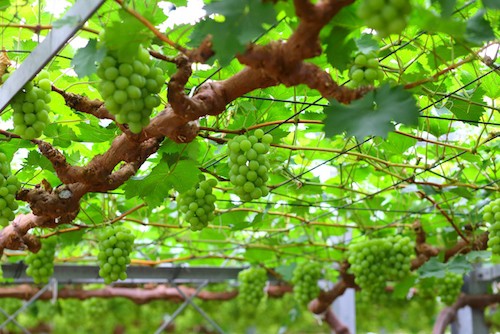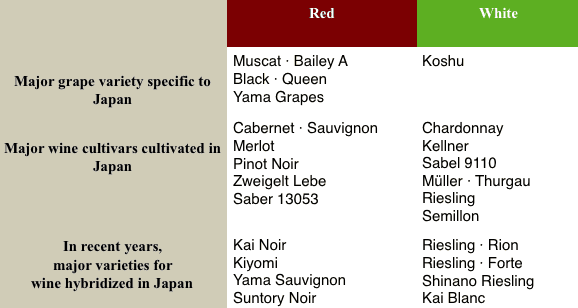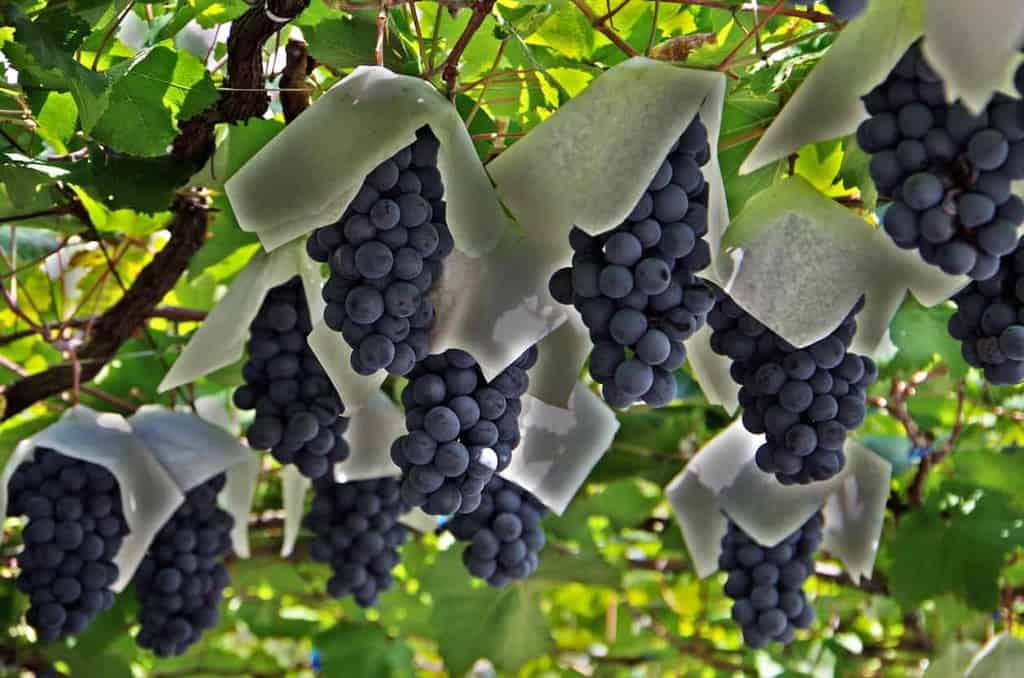Getting to Know Japanese Wine
Japan is a magical place with some of the most delectable culinary experiences in the world. Typically, meals are paired with sake or beer, but Japanese wine has a place at the table as well. Known for delicacy in style, these wines make lovely compliments to most regional dishes.
Japan makes wine?
Yup. It all started in the Yamanashi prefecture in the 1870’s, when two men returned from studying wine production in France and decided to give it a try. This eventually became Chateau Mercian, the first private winery in Japan. It is still in operation and has plans to double its production according to The Drinks Business. From there, wineries began popping up all over Japan, with the major production areas being Yamanashi, Hokkaido, Nagano and Yamagata. There are over 300 wineries in Japan today.
RELATED: Unique Wineries to Visit Around the World
Cultivation methods vary among each of these vastly different climates. Honshu and Kyushu, for example, are known for being incredibly wet most of the year. In addition to this, typhoons with heavy rainfall and strong winds are common in the fall. This can make the vineyards particularly susceptible to diseases and pests. They must be especially vigilant and meticulous in these vineyards, but as we know, the Japanese are known for their precision and dedication.
Japanese Wine Grape Varieties and Styles

Japan is known for having an affinity for natural wine. Purity of flavor and production is an obvious fit for Japanese cuisine. Tokyo is a natural wine lover’s paradise. I had the unique opportunity to try Koerner wines at Wine Stand Bouteille in Shibuya before they had made their way into the states. Knowing that the Japanese palate is in tune with this style of wine, it makes sense that the wines they produce are generally in line with this way of thought. Most Japanese wines are straightforward and pure and a number of wineries produce natural wines.
Jun Nagahashi, owner of natural wine bar, Wineba in Chofu has a focused list of small farmer wines –Grape Republic in Yamagata being his favorite.
“I love Vin Nature wine. Just like putting grapes in my mouth, the taste and fragrant aroma is of the grape–that is why I like it.” – Jun Nagahashi
Marie Tanaka, owner of Wine Styles shop in Okachimachi, says most of her sales come from Japanese people who enjoy pairing regional wines with Japanese foods.
“Grapes like Delaware, Niagara, Muscat, Adirondac semi-sweet or sweet wines are popular. Recently tourists from overseas stop at my shop and buy Japanese wines for presents,” says Tanaka.
In Ryusei Kobayashi’s, Sake and Wine Bar in Sendai—Nikyo, he serves Japanese wine only. While finding the best examples of natural wine.
“In Japan it is difficult to do wine making in a natural way, due to the difficulty of the cultivation environment–for example, it is very rainy. However, a large number of small wineries in Japan carry out cultivation in a way that is as natural as possible,” said Kobayashi whose main operations are Obuse Winery, Domaine Takahiko and Akiu Winery.
The varietal most often seen is Koshu, a hybrid indigenous to Japan with a thick-skin that helps it survive damp summers. It makes a soft and fruity wine boasting citrus and peach. The grape travelled along the Silk Route and found it’s home in Yamanashi, within the foothills of Mount Fuji.
In Nagano, Koshu is rarely cultivated. Instead, they focus on major grape varieties like Chardonnay and Merlot. Tsuyoshi Takemura of Mashino Winery prefers to work with these grapes, as well as cider apples.
Other varieties are seen below in the chart from the Japanese Wineries Association.

Wine Regions of Japan
Japan, as we’ve discussed, has historically been known for its sake production, but has been steadily gaining international recognition for its winemaking, too.
Its unique climate, geography, and dedication to quality have led to the development of diverse and dynamic wine regions. The main wine regions of Japan include Yamanashi, Hokkaido, Nagano, and Niigata. Let’s take a deeper look into each of these Japanese wine regions.
Yamanashi
Located west of Tokyo and nestled near the base of iconic Mount Fuji, Yamanashi is the epicenter of Japanese winemaking. The region is blessed with a temperate climate, ample sunshine, and rich volcanic soils, which together create an ideal environment for viticulture.
Yamanashi is known for its production of Koshu, a unique grape variety native to Japan. Koshu wines are typically light-bodied and aromatic, with high acidity and delicate flavors that are a perfect match for Japanese cuisine. Besides Koshu, international varieties like Chardonnay and Merlot are also grown here.
Visiting Yamanashi is a delight, with many wineries open for tours and tastings, such as the well-known Château Mercian winery.
Hokkaido
Japan’s northernmost island, Hokkaido, boasts a cool climate akin to classic European wine regions. This climate, combined with the region’s fertile soils, makes Hokkaido an exciting frontier for Japanese winemaking.
The region produces an array of grape varieties, with a focus on cooler-climate varieties like Pinot Noir, Gewürztraminer, and Chardonnay. There are also experimental plantings of lesser-known varieties.
Visitors to Hokkaido can explore its beautiful vineyards, many of which, like the renowned Yoichi winery, are open for tours and tastings.
Nagano
Nagano, nestled in the Japanese Alps, is one of the country’s most promising wine regions. It benefits from high altitude, a large diurnal temperature range, and long hours of sunshine, which contribute to the development of complex flavors in the grapes.
The region has a focus on international grape varieties, including Merlot, Chardonnay, and Pinot Noir. However, the local hybrid variety Shinano Riesling is also gaining recognition.
Several wineries in Nagano are open to the public, including the award-winning Domaine Sogga (also known as Obusé Winery), where visitors can sample the region’s distinctive wines.
Niigata
Niigata, located on the western coast of Honshu, is primarily known for its sake production, but it also has a burgeoning wine industry. The region’s heavy snowfall and resulting high-quality meltwater, along with its fertile soils, create unique conditions for grape growing.
Niigata mainly produces international varieties, including Chardonnay, Pinot Noir, and Merlot. Several wineries, like Pâtisserie & Wine Erenbourg, are open for visitation and provide an exciting glimpse into this emerging wine region.
Top Wineries to Visit in Japan
Japan’s burgeoning wine scene is home to numerous remarkable wineries, each with its own unique story, style, and selection of wines. From the iconic slopes of Yamanashi to the cool climates of Hokkaido, these wineries encapsulate the variety and quality of Japanese viticulture. Here’s a spotlight on some of the best wineries you can visit in Japan.
Château Mercian
Located in the heart of Yamanashi, the country’s premier wine region, Château Mercian is considered one of Japan’s leading wineries. The winery has played a crucial role in the evolution of the Japanese wine industry, pioneering the production of quality Koshu wine and international grape varieties like Merlot and Chardonnay.
What sets Château Mercian apart is its commitment to express the distinct terroir of Yamanashi in its wines. A tour of the winery offers insight into the art of Japanese winemaking, and a tasting will allow you to sample the delicate, aromatic Koshu and the rich, complex Chardonnay.
Yoichi Winery
Located on the northern island of Hokkaido, Yoichi Winery embraces the region’s cool climate to produce European-style wines with a unique Japanese twist. Their approach to winemaking focuses on Pinot Noir and Chardonnay, yielding wines with delicate yet complex flavors.
The winery is set in a beautiful location, and visitors can enjoy a walk in the vineyards, tour the production facilities, and, of course, taste their remarkable wines. It’s a must-visit for anyone interested in Japan’s unique approach to classic wine styles.
Domaine Sogga (Obusé Winery)
In the mountainous region of Nagano, Domaine Sogga, also known as Obusé Winery, creates noteworthy wines that reflect the local terroir. Specializing in international varieties such as Merlot and Pinot Noir, the winery also nurtures Shinano Riesling, a hybrid grape that’s gaining recognition for its crisp, aromatic wines.
Visitors can tour the winery, stroll through the picturesque vineyards, and sample a variety of their award-winning wines. Domaine Sogga’s commitment to quality and innovation makes it a standout on Japan’s wine map.
Pâtisserie & Wine Erenbourg
Situated in the coastal region of Niigata, a region renowned for its sake, Pâtisserie & Wine Erenbourg stands out for its unique combination of pastries and wines. The winery grows international grape varieties such as Chardonnay, Pinot Noir, and Merlot, which are artfully paired with their baked goods for a truly unique tasting experience.
With its warm and inviting atmosphere, Pâtisserie & Wine Erenbourg provides an excellent introduction to Niigata’s wine industry and the potential of this exciting emerging region.
Keep Your Eyes, Ears, Nose and Palate on Japanese Wine
If you are someone who is keen on watching a region grow and find their niche, keep your ear to the ground about wines from Japan. While opportunities in the U.S. to taste these wines are limited, hopefully in the near future more brands will make their way here. A chance to taste some of the farmer wine adored by Japan’s natural wine scene would be an ideal situation. If you are interested to try some Japanese wine for yourself right now, these are a few options to seek out in the States:
- Rita Farm & Winery Izayoi Niagara Wine
- Château Mercian Momoiro Rosé
- Chateau Jun Koshu
